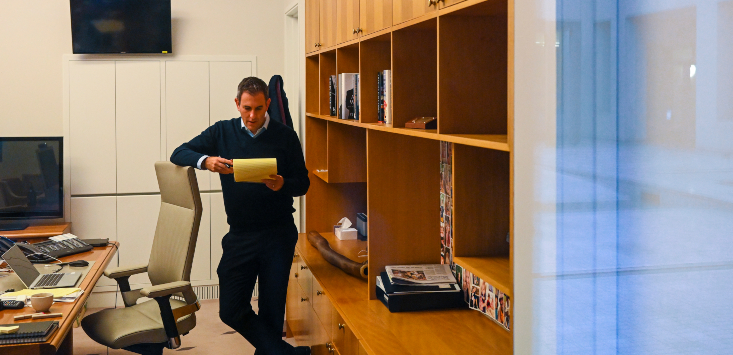
Source: AAP Image / Lukas Coch
A lot can change in six months. Just ask Treasurer Jim Chalmers, who will on Tuesday deliver a vastly different federal budget to the economic roadmap laid out by the Coalition in March.
Chalmers says Labor’s first federal budget in nearly a decade will focus on community wellbeing, with a tranche of “sensible” measures designed to help Australians battling the soaring cost of living.
That said, the Treasurer also says the budget will be defined by harsh and persistent economic circumstances, suggesting the big-spending bravado of recent Coalition budgets is well and truly over.
Here’s what we know about the document so far.
1. Cost-of-living support, but not as you know it
The rising cost of living is a key concern for households and small businesses. A recent survey by CPA Australia found 67% of respondents expect the government to make cost-of-living support the centrepiece of its budget.
But Australians shouldn’t expect the kind of cash-splashing, stimulatory support measures of years gone by in tomorrow’s budget.
Since Labor took office, Chalmers has expressed serious concern about the nation’s economic position, with the Treasury downgrading pre-election GDP forecasts and boosting its inflation projections.
Tuesday’s budget will reportedly estimate GDP growth of 1.5% in 2023-2024, down from the 2.5% estimated in the Treasury’s pre-election update.
Wednesday will also bring Consumer Price Index readings for the September quarter, which are heavily tipped to show inflation surging past the annual 6.1% rate recorded in the June quarter. In a sign of things to come, Treasury expects the figure to hit 7.75% annually in December.
All of this means the government is unlikely to emulate the financial stimulus of recent years, especially measures likely to put money directly into the pockets of consumers.
“We do understand that people would like us to be there when times are tough, and we are, and we will be in this budget,” Chalmers told the ABC Saturday.
“But our responsibility when we’ve got lots of inflation is not to spray money around in an indiscriminate or untargeted way because that would make our inflation problem worse.”
2. Short-term positives outweighed by persistent negatives
Soaring resource prices have significantly improved the near-term outlook, with the government expected to tally an extra $100 billion in revenue over the next four years off the back of iron ore, gas, and coal exports.
Even that won’t be enough for the government to turn on the cash taps, with Chalmers claiming Labor has inherited “structural, persistent spending pressures” from the prior government.
Following what Chalmers and Minister for Finance Katy Gallagher have described as a “line by line” budget audit, The Australian Financial Review states the government has axed or reworked $21 billion in spending greenlit by the Coalition.
Those cuts will be detailed in Tuesday’s release, but Labor has already highlighted what it has described as wasteful spending: in July, Labor said the Coalition concealed that modernising the business registry system will cost $1 billion more than first expected.
3. Inflation a problem for businesses, households, and governments alike
At the same time rising interest rates are clamping down on the ability for businesses and households to borrow, the cost of government borrowing is also on the rise. Chalmers said interest on government debt, some $895 billion of it, is the fastest-growing cost on the government’s books.
With headline-grabbing stimulus measures highly unlikely, there’s also mixed news for workers banking on a wage hike to compensate for the cost of living.
“The budget will show that wages will move substantially, but they won’t cross over in our estimation or the Treasury’s estimation until we get that inflation under control,” Chalmers said.
In other words, pay packets are set to increase, but inflation is still expected to surpass wage growth until some time in 2024.
4. Lessons learned from the UK
There’s one more reason not to expect massive stimulatory spending in Tuesday’s budget.
The United Kingdom is still reeling from September’s ‘mini-budget’, which called for £45 billion ($80 billion) in unfunded tax cuts — at the same time the Bank of England was hiking interest rates in the hopes of clamping down on inflation.
Prime Minister Liz Truss and Chancellor of the Exchequer Kwasi Kwarteng’s decision to push ahead with stimulatory fiscal policy not only worked against the central bank’s monetary policy, it nearly exploded the UK’s bond market, pummeled the pound, and resulted in the resignation of both Truss and Kwarteng after just weeks in power.
The Reserve Bank of Australia has reduced the intensity of its monthly cash rate hikes, but with inflation all but certain to trend upwards, further interest rate increases aren’t out of the question.
“You need to make sure that governments aren’t working against the difficult job that central banks are asked to do,” Chalmers said of the UK tumult.
“And I think what we’ve done in the budget is we have nicely lined up those two things.”
5. But Stage 3 tax cuts likely to remain
That said, the government is unlikely to scrap the highly-disputed Stage 3 tax cuts, which were brought forward by the Coalition and passed into law with Labor’s blessing.
The cost of those tax cuts, which predominantly benefit high income-earners, is slated to blow out to $254 billion over 10 years, Chalmers revealed last week.
Given the budgetary pressures Labor has clearly and consistently outlined, the government is facing pressure from the Greens and think tanks like The Australia Institute to ditch the cuts before they come into effect next year.
So far, at least, Chalmers says Tuesday’s budget is not the time to make such a significant reversal.
6. Parental leave extension
That all goes some way to explaining why Tuesday’s budget will be free of “firecrackers and razz-a-matazz”, in the words of Assistant Treasurer Stephen Jones.
We’re about to deliver our first budget. Here’s what will, and won’t, be in it. pic.twitter.com/avmvjdMsQq
— Stephen Jones MP (@StephenJonesMP) October 24, 2022
But the federal government has revealed some measures destined to have a significant impact on Australia’s business community.
Labor has confirmed an expansion of the paid parental leave scheme, tacking an extra six weeks onto the existing allowance.
In effect, parents will have six months of leave to share by 2026, paid at the equivalent of the minimum wage.
The government says will provide more flexibility and certainty to families.
“Having a child shouldn’t be an economic barrier for families or indeed act as a handbrake on the broader economy,” Gallagher said of the measure.
With unemployment at decade-low levels, Labor has also positioned the move as one which will boost workforce participation.
7. More university places for high-demand careers
Another cornerstone of Labor’s policy platform is the expansion of university places for high-demand occupations and the creation of new free-free TAFE places.
The Age reports the plan to extend Commonwealth funding support to 20,000 new university places will cost $485.5 million over four years, with those figures entrenched in Tuesday’s budget.
More than 4000 teaching degrees will be subsidised under the plan, as the education sector grapples with a severe shortage of qualified staff.
Thousands more will be created in the fields of IT, nursing, and engineering.
8. Funding for visa processing as worker shortages bite
More immediate relief is expected for industries suffering workforce shortages in the form of accelerated visa processing.
Some $36.1 million has been earmarked to boost workforce numbers in the Department of Home Affairs, with the goal of clearing a pandemic-era backlog of visa applications.
Beyond the immense personal toll that delayed visa applications can take on individuals and families, businesses across the nation have called for an urgent expansion of the migration system to plug gaps in the workforce.
Labor has already confirmed a permanent migration intake upgrade of 35,000 places, bringing the 2022-23 rate to 195,000.
9. Critical minerals strategy to power renewable tech sector
More than $100 million will flow towards a new critical minerals strategy, designed to capitalise on resources essential to renewable energy technology.
Revealed on Friday, the scheme will see $50.5 million over four years flow towards the Australian Critical Minerals Research and Development hub.
That project, launched in collaboration with CSIRO, Geoscience Australia and the Australian Nuclear Science and Technology Organisation, will work with industry leaders to counter technical challenges and maximise development opportunities.
Another $50 million will go towards grants for early- and mid-stage critical mineral projects.
The main game here is lithium — a mineral that is crucial to forward-thinking battery and electric vehicle technology.
Australia is already the world’s top lithium producer, and the extra funding will “help bring online new sources of supply, support robust supply chains, and create high-paying regional jobs for Australians,” Minister for Resources and Northern Australia Madeleine King said.
10. Mental health support, debt counselling for small business
Given the persistent hardships facing business owners, the federal government says it will devote $15 million in funding to dedicated mental health support services and debt counselling hotlines.
The NewAccess for Small Business Owner program, operated by BeyondBlue, partners business owners with specialised mental health professionals. It is free to use for callers.
That funding will also bolster the efforts of the Small Business Debt Helpline, operated by Financial Counselling Australia.
Handpicked for you

Budget 2022: Here’s what small businesses want — and definitely don’t want — in next week’s federal budget



COMMENTS
SmartCompany is committed to hosting lively discussions. Help us keep the conversation useful, interesting and welcoming. We aim to publish comments quickly in the interest of promoting robust conversation, but we’re a small team and we deploy filters to protect against legal risk. Occasionally your comment may be held up while it is being reviewed, but we’re working as fast as we can to keep the conversation rolling.
The SmartCompany comment section is members-only content. Please subscribe to leave a comment.
The SmartCompany comment section is members-only content. Please login to leave a comment.